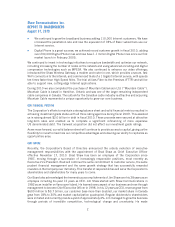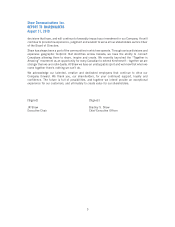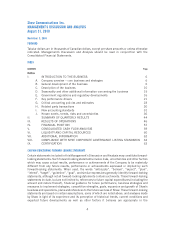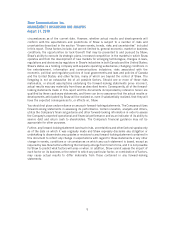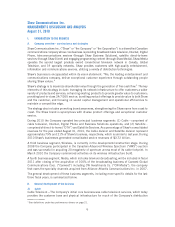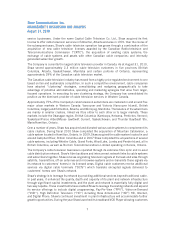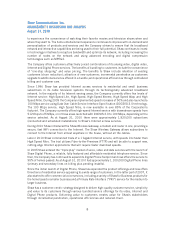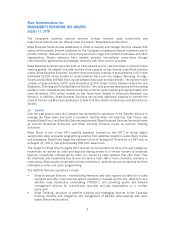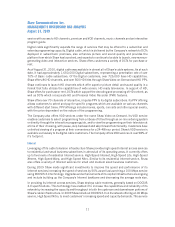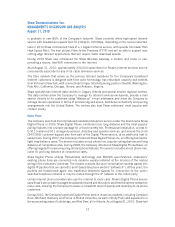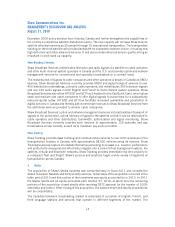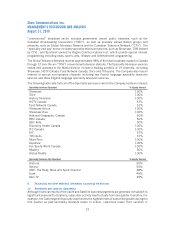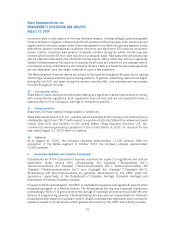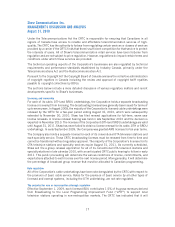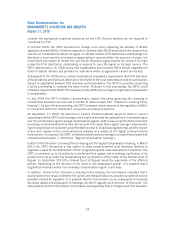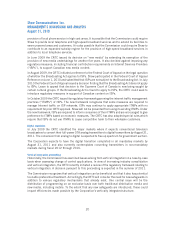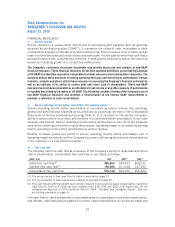Shaw 2010 Annual Report Download - page 16
Download and view the complete annual report
Please find page 16 of the 2010 Shaw annual report below. You can navigate through the pages in the report by either clicking on the pages listed below, or by using the keyword search tool below to find specific information within the annual report.is available in over 85% of the Company’s footprint. Shaw currently offers high-speed Internet
service with downstream speeds from 512 Kbps to 100 Mbps, depending on the service selected.
Late in 2010 Shaw commenced trials of a 1 Gigabit Internet service, with speeds 10x faster than
High Speed Nitro. The trial utilizes Fibre-to-the-Premises (FTTP) and will be able to support new,
cutting-edge Internet applications that will require faster download speeds.
During 2010 Shaw also introduced the Shaw Wireless Gateway, a modem and router in one,
providing a secure, fast WiFi connection to the Internet.
As at August 31, 2010, approximately 230,000 subscribers for Shaw’s Internet services did not
concurrently subscribe for any of its cable television services.
The fibre network that serves as the primary Internet backbone for the Company’s broadband
Internet customers is designed with fibre optic technology, has redundant capacity and extends
from Victoria to New York, with connectivity to major Internet peering points in Seattle, Washington;
Palo Alto, California; Chicago, Illinois; and Ashburn, Virginia.
Shaw operates two Internet data centres in Calgary, Alberta and several smaller regional centres.
The data centres allow the Company to manage its Internet services exclusively, provide e-mail
service directly to its customers using “@shaw.ca” e-mail addresses, and allow the Company to
manage its own operations in terms of provisioning web space, backbone connectivity and peering
arrangements into the United States. The centres also host Shaw customers’ most popular web
content locally.
Digital Phone
The Company launched its fully featured residential telephone service under the brand name Shaw
Digital Phone in 2005. Shaw Digital Phone combines local, long distance and the most popular
calling features into a simple package for a fixed monthly fee. Professional installation, access to
E-911 (enhanced 911 emergency service), directory and operator services, and around-the-clock
(24/7/365) customer support also form part of the Digital Phone service, at no additional cost to
subscribers. During 2007, the Company introduced Shaw Digital Phone Lite, an offering tailored for
light long distance users. The service includes a local phone line, popular calling features and long
distance at competitive rates. During 2008, the Company introduced Shaw Digital Phone Basic, an
offering targeted for users requiring limited phone features. The service includes a local phone line,
caller ID and long distance at competitive rates.
Shaw Digital Phone utilizes PacketCable technology and DOCSIS specifications. Customers’
existing phone lines are connected into modems usually installed at the location of the central
wiring in the customers’ premises. The modem converts the voice conversation (sounds waves) into
digital IP packets that are carried to an IP-based telephone switch (“softswitch”). At this point, the
packets are transformed again into traditional telephone signals for connection to the public
switched telephone network or may be routed through the IP network to the called party.
Unlike internet phone providers who use the internet to route calls, Shaw’s Digital Phone service
uses Shaw’s own private managed broadband network and the public switched telephone network to
route calls, allowing the Company to ensure a consistent level of quality and reliability to its phone
customers.
During 2010, the Company launched Digital Phone service in various markets, including Campbell
River, Winfield, Kimberly and Fernie in British Columbia, as well in Stony Plain and expansions in
the surrounding areas of Lethbridge, and Red Deer, all in Alberta. As at August 31, 2010, Shaw had
12
Shaw Communications Inc.
MANAGEMENT’S DISCUSSION AND ANALYSIS
August 31, 2010


